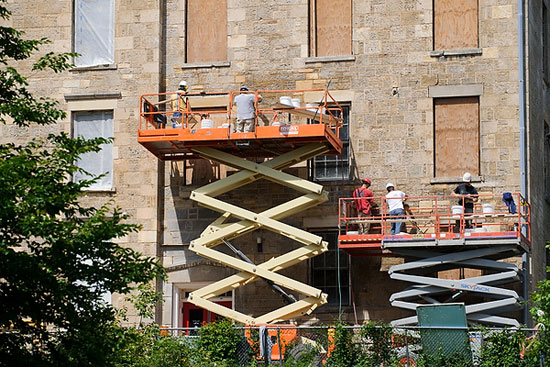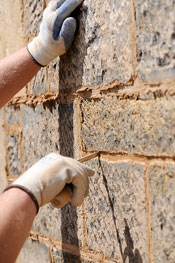Work on North and South Halls preserves history, character

Working from a lift-platform, construction workers repair damaged stonework and deteriorating mortar on the exterior of South Hall on June 14, 2011. The restorative work includes replacement of windowpanes and repair of damaged stones and door headers of historic North and South Halls.
Photo: Jeff Miller
The two oldest buildings on the University of Wisconsin–Madison campus have gotten a strong dose of tender loving care in recent months, with careful attention to preserving their historic status and character.
Because North Hall and South Hall are the earliest buildings constructed on campus, they help connect the present to the past.
Specially trained construction crews have been working since last fall to replace mortar, fix damaged stonework and repair and re-glaze windows in the two building that date to the middle of the 19th century.
Matt Collins, project manager on the North and South Hall exterior renovation, noted that the repairs — which should be complete by fall — were necessary for the upkeep of these buildings.
“A significant amount of work is needed simply because of routine maintenance and the age of the buildings,” he says. “However, some of the repairs are needed because of the long-term effects of previous construction methods.”

The labor-intensive stone repairs involve use of a traditional lime-putty mortar that must be progressively packed, tucked, moistened, dried and brushed clean nine times.
Photo: Jeff Miller
Since its construction in 1851 as the first building on campus, North Hall has served as a dormitory, museum, classroom, mess hall, and library, and was declared a national historic landmark in 1965.
South Hall was built four years later across Bascom Hill and both buildings have undergone considerable exterior renovations in the past year. Today, it is home to the College of Letters and Science.
Both structures were built of locally quarried sandstone.
The process started in 2004, when Isthmus Architecture, along with the state Department of Administration’s Division of State Facilities conducted the North and South Halls Masonry Restoration Studies. Experts found that the exterior stone of North Hall was deteriorating and needed a sound preservation strategy.
According to the report, the combination of weather, age, and well-intended but damaging repairs had taken a toll on the stone facades of North and South Halls. Because of this its historic status, university facilities officials considered repairing North and South Halls a high priority.
Last fall, crews began replacing window panes, and repairing damaged stones and door headers on both buildings.
Collins noted that the original mortar used to the build North and South Hall was lime putty. Faster-curing cement was not manufactured in the United States until 1872. Most of the previous repairs on the buildings were repointed with a Portland cement mortar, causing problems over the long term.
According to Collins, the cement mortar has been removed and lime putty mortar is being used for repointing for this project. This new lime putty mortar is intended to match the texture and color of the original mortar. Though some stones required more attention, most of the stone is in good condition, Collins says.
Dan Okoli, university architect and director of capital planning and development, says nothing will change in the physical sense, but the buildings will be in better shape.
Because North Hall and South Hall are the earliest buildings constructed on campus, they help connect the present to the past. Okoli also adds that it is a good, sustainable practice to preserve old buildings.
“These historic places reflect our history and values as a university,” he says. “They represent, in part, the flow of institutional culture over time.”
